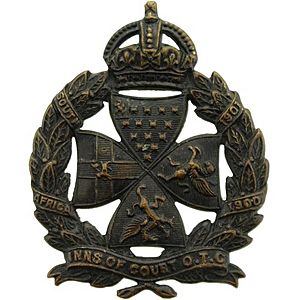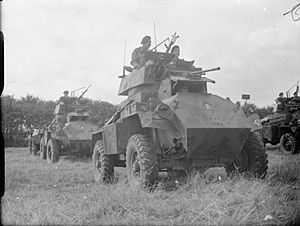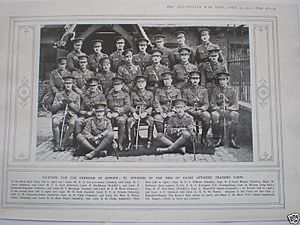Inns of Court Regiment facts for kids
Quick facts for kids Inns of Court Regiment |
|
|---|---|

Inns of Court OTC cap badge
|
|
| Active | May 1932 – May 1961 |
| Country | |
| Branch | |
| Type | Infantry / Cavalry |
| Garrison/HQ | 10 Stone Buildings, Lincoln's Inn |
| Nickname(s) | "The Devil's Own" |
The Inns of Court Regiment (ICR) was a special part of the British Army. It existed under that name from May 1932 to May 1961. However, this military unit has a much longer history, going back to at least 1584. Today, its name lives on within 68 (Inns of Court & City and Yeomanry) Signal Squadron, which is part of the 71st (City of London) Yeomanry Signal Regiment.
Contents
- Early History of the Inns of Court Regiment
- The Napoleonic Wars and "The Devil's Own"
- Joining the Volunteer Force (1859–1908)
- The Inns of Court in World War I
- Changes Between the World Wars (1920–1940)
- The Inns of Court Regiment in World War II
- Changes After World War II (1947–1969)
- Battle Honours
- Regiment Badge and Motto
- Regiment Museum
Early History of the Inns of Court Regiment
In the 1300s to 1500s, judges and lawyers sometimes had to do things that aren't part of their job today. Members of the Inns of Court (which are like professional associations for lawyers) were called upon to fight in wars. For example, they fought in the wars of King John and against Robert the Bruce.
One time, in 1381, they helped defend Medieval London against Wat Tyler during the Peasants' Revolt. In 1467, a Chief Justice helped defeat an attack on London. There are also stories from 1554 about smaller fights involving members of Gray's Inn and Lincoln's Inn.
The first organized group formed by the Inns of Court was in Holborn, London, in 1584. At that time, groups called trained bands were created to help defend England from the Spanish Armada. A document from Lincoln's Inn, signed by Thomas Egerton, shows how these lawyers joined together.
The history after this is a bit unclear. Many lawyers joined the Royalists, and their clerks joined the Parliamentarians, during the English Civil War. Members of the Inns were also called to action during the Jacobite rising of 1745 and the Gordon riots of 1780. Even a future prime minister, William Pitt the Younger, served in the Lincoln's Inn Company.
The Napoleonic Wars and "The Devil's Own"
The Bloomsbury and Inns of Court Volunteers was formed again in 1797 during the Napoleonic Wars. It was around this time that the regiment got its famous nickname.
In 1803, King George III was reviewing the troops in Hyde Park. He wasn't a big fan of lawyers, especially armed ones! When the "Temple companies" (made up of lawyers) marched past, the King asked Lord David Erskine, who was leading them, what kind of soldiers they were. Erskine replied, "They are all lawyers, Sire." The King exclaimed, "What! What! All lawyers? All lawyers? Call them the Devil's Own, call them the Devil's Own!" And so, they became known as "The Devil's Own."
Joining the Volunteer Force (1859–1908)
The modern history of the regiment started in 1859, after the Crimean War. This was when the 23rd Middlesex (Inns of Court) Rifle Volunteer Corps was formed. In 1881, it became part of the Rifle Brigade. It was renamed the 14th Middlesex (Inns of Court) Rifle Volunteer Corps in 1889.
The regiment then became part of the 2nd London Volunteer Brigade. In 1888, a mounted infantry group was formed. This group became "B" (M.I.) Company. A small group of 30 mounted infantry, 19 cyclists, and a signaller joined the City Imperial Volunteers to serve in South Africa during the Boer War.
In 1908, the Territorial Force was created. The regiment became the 27th (County of London) Battalion, The London Regiment (Inns of Court). But soon after, it changed into an officer training unit called the Inns of Court Officers' Training Corps (I.C.O.T.C.). The regiment had one cavalry squadron and three infantry companies.
The Inns of Court in World War I
In 1914, the Inns of Court Reserve Corps was formed. It was made up of former members of the Inns of Court Rifle Volunteers. In 1917, the 1st Cadet Battalion, Inns of Court, was created to train boys who were too young for military service.
The Inns of Court OTC grew very quickly in August and September 1914. Thousands of people volunteered for military service when World War I began. The corps soon became too big for its London base. A training camp opened in tents on Berkhamsted Common in September 1914. This camp stayed open until June 1919 and trained about 2,000 officer cadets. As part of their training, the men dug about 13 miles (21 km) of trenches across Berkhamsted Common. You can still see signs of these trenches 100 years later.
Around 11,000 people from the Inns of Court OTC became officers in other units. Three of them were awarded the Victoria Cross, which is a very brave award, but sadly, they received it after they had died. These heroes were Jack Harrison (1917), Walter Napleton Stone (1918), and Christopher Bushell (1918).
World War I Memorial
The Inns of Court Officers' Training Corps Memorial is a First World War memorial. It is located near the temporary training camp on Berkhamsted Common. This memorial became a Grade II listed building in November 2016.
Changes Between the World Wars (1920–1940)
In 1920, the regiment was reorganized. It had one squadron of cavalry and two companies of infantry. Its name changed to the Inns of Court Regiment (ICR) in 1932. The two infantry companies became light tank cavalry squadrons in 1937. Two years later, they formed the Royal Armoured Corps Wing at Sandhurst. In 1939, the mounted squadron joined a cavalry training regiment in Edinburgh, but this was disbanded in 1940.
The Inns of Court Regiment in World War II

From January 1941 to January 1943, the regiment was part of the 9th Armoured Division in Great Britain. From 1943, it was directly controlled by I Corps. This was a key attack group of the 21 Army Group. Later, the regiment led the advance of the 11th Armoured Division.
On D-Day, "C" Squadron of the regiment landed on Juno Beach with the 3rd Canadian Infantry Division. Their mission was to quickly move inland to the River Orne, south of Caen. They needed to destroy the main river crossings from Thury-Harcourt to a point five kilometers south of Caen. They also had to prepare four crossings on the Odon for demolition. The goal was to stop enemy reinforcements, especially the 21st Panzer Division.
To do this, "C" Squadron was split into smaller groups. There were twelve fighting units. Nine of these had a group of Royal Engineers and a half-track vehicle with explosives. All their vehicles were loaded onto two L.C.T’s. They divided the vehicles equally so that if one landing craft was lost, the other could still complete the mission. "C" Squadron was supposed to land thirty minutes after the first attack infantry on Juno Beach, just west of Graye-sur-Mer.
During the campaign in Northwest Europe in 1944–45, the Inns of Court was an armoured car regiment. They were used for reconnaissance, which means scouting ahead to gather information for I Corps.
Changes After World War II (1947–1969)
On April 1, 1947, the regiment was reformed. It became the Armoured Car Regiment of the 56th (London) Armoured Division, T.A. Later, it became the Reconnaissance Regiment of the 54th (East Anglian) Infantry Division.
In 1956, the Northamptonshire Yeomanry was reduced in size and joined with the Inns of Court Regiment. It became "The Northamptonshire Yeomanry "D" Squadron, The Inns of Court Regiment." This changed again in 1961. The Inns of Court Regiment joined with the City of London Yeomanry (Rough Riders) to form The Inns of Court & City Yeomanry.
After more changes in defense, the unit became known as 68 (Inns of Court & City Yeomanry) Signal Squadron from April 1, 1969. It became part of the new 71 (Yeomanry) Signal Regiment (Volunteers).
Battle Honours
The regiment earned special recognition for its bravery in these battles:
- South Africa 1900–01
- The Second World War:
- Normandy Landing
- Caen
- Bourguébus Ridge
- Cagny
- Catheolles
- Amiens 1944
- Antwerp
- Hechtel
- Rhine
- Leese
- Aller
- North-West Europe 1944–45
Regiment Badge and Motto
The cap badge of the regiment combined the symbols of the four Inns of Court. The Latin motto of the corps is Salus populi suprema lex. This means "the safety of the people is the supreme law."
Regiment Museum

You can visit the Inns of Court and City Yeomanry Museum at 10 Stone Buildings, Lincoln's Inn, London, WC2A 3TG.




